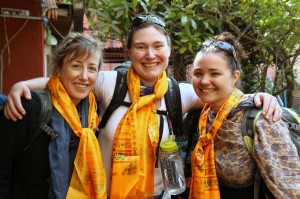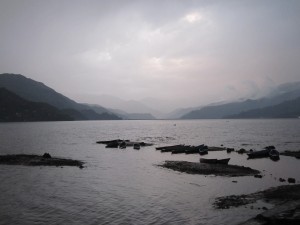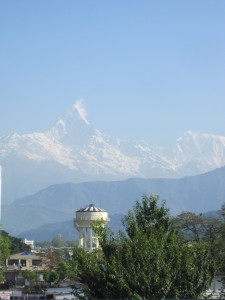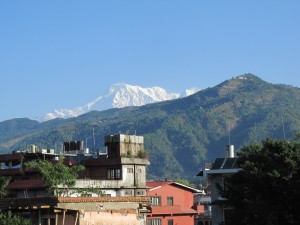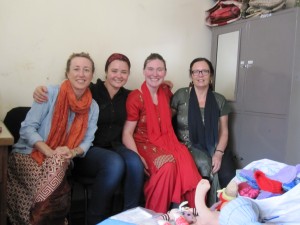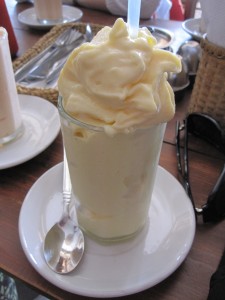After a lovely breakfast with our Nepal buddies, Dr. Mickey and Cathy, we headed to the airport. Before we headed off, Bishnu adorned us with these scarves for safe travel and Mickey pulled out his fancy camera to take our picture.
All posts by jacquelyn thorne
Snapshots
The Legendary Lassi
On Reflection
I’ve spent the last week or so starting to digest the experience we had in Nepal. I probably won’t do an earthquake reflection, as Rachelle already so eloquently captured much of what we were all feeling. That said, I can’t say that experience hasn’t changed me, or framed my experience in Nepal – because it would be impossible for it not to. However, today I’d like to focus on the parts of this experience that really delighted me and made me recognize the value of our education here in Canada, and the good work we can do elsewhere in the world.
Our first experience of birth in Nepal was attendance at the birth centre in Kathmandu – in a teaching hospital. We were told at the time of how wonderful that experience was, though our presence felt a bit intrusive to us, in our jet-lagged state. We learned later that this experience really was absolutely wonderful, especially when compared with our later observations in Pokhara. Fortunate for us, we moved on to Baglung, arriving 15 minutes before the earthquake struck, taking us farther away from the epicentre and to a hospital that welcomed us with open arms. Though we all felt a bit dopey after the earthquake, as the aftershocks carried on, we were invited at every opportunity to provide care for women at the Baglung hospital, and had a wonderful time working with the Nepali nurses and doctor in providing care.
We began attending births on the Monday following the earthquake, which happened around noon on Saturday. The Baglung hospital was about a 5 minute walk from our hotel, a walk which occurred along a dirt road, with vibrant shops of all kinds lining the street as the bottom floor of low-rise buildings. At the hospital, the staff had moved all maternity patients down to the first floor, and deliveries were taking place in the minor procedure room located down the hall from where the women were labouring or recovering postpartum. Women would come into the hospital, some from quite far away by Jeep, or by foot, and would be assessed and laboured in or around their bed in the open ward. Then, as their moaning grew stronger and they started to act pushy, they would be brought into the minor procedure room, assessed for dilation and usually proceeded to push their babies out. Our first catch went to Emma, who headed in with Cathy on that Monday afternoon. The next day we went in together and Emma got her second catch in the minor procedure room, while I was able to help with the somersault maneuver for a baby born with the cord around its neck. That turned out to be good timing, as we were able to teach the somersault maneuver two days later at one of our continuing education workshops. I was lucky because this baby came out fast and furious, in the hallway between the labour/postpartum beds and the minor procedure room. Attending births helped to take our minds off the aftershocks and allowed us to experience and participate in birth in Nepal.
The following day, Rachelle got her first catch and we taught our first continuing education workshop. As it turns out, teaching the workshops was a real blessing. We were able to watch all of the nurses and the head doctor light up as they watched various global health videos in Nepali on the eight danger signs of the newborn baby, immediate care after birth and care of the mother during labour. We then got to work demonstrating various skills like three different ways to deliver a baby with a cord around its neck (which included the somersault maneuver), neonatal resuscitation (according to the Helping Babies Breathe protocol) and delayed cord clamping. We learned how to simplify our language and speak more slowly so we could be understood. We also learned how to connect with the nurses and doctor attending, by smiling, encouraging, giving the thumbs up and laughing together.
These are the parts of Baglung that in the last week I have imprinted into my mind. Though our time there was short, we so enjoyed working to take our minds off of the reality of what happened on arrival. To reframe things in my mind, I’ve spent time thinking about the wonderful connections we made there and the real potential for students to be welcomed back there next year. All of Cathy’s hard work paid off in getting us to this wonderful place where we could start to feel confident in our own skills, and work in teaching others by example and through more formal channels. I feel so fortunate to have been able to participate in the daily operations of the Baglung hospital and to have gained the trust of the nurses, doctor and most importantly the Nepali women, who were so strong and so much more supported here than what we witnessed elsewhere.
Safe in Baglung
Just a quick update for those following. We arrived in Baglung, which is about 80km west of Pokhara on Saturday about a half hour before the earthquake hit. We safely made our way into the road during the first tremor and stayed together with the locals. We are staying at a hotel that has both a new building and an older building and after that experience promptly agreed on a room in the new building. The subsequent night was tumultuous, but we made it through safely, with our earthquake plan in place. It takes us less than 30 seconds to get out to the courtyard of our hotel.
Last night was a much better night. We slept well and headed off to the hospital in the morning, where two women are being induced. The hospital has been our most welcoming yet! We really feel we’ll be able to get the hands-on experience we’ve been craving, as well as bringing some love and peace to the women here.
After lunch today, we find ourselves once again in the courtyard (which is our most favourite place in the daytime) observing as men from the community setup a little square, with bricks and tree branches, colorful metallic flags and sand. In broken English we found out that these are preparations for a wedding that is happening tomorrow! About 500 people are apparently attending! We are quite excited and planning to wear our fancy kurtas! This is such a lovely reminder that life must carry on. And that the people here feel strongly that the worst is hopefully over.
It’s been so lovely to chat with our loved ones over the last few days. We will hit 72 hours around noon tomorrow, which is when they will start moving patients back up into floors above the first in the hospital. I think once we make that milestone we will start to feel more like ourselves again.
Our love and prayers go out to those less fortunate. We are doing well and are so lucky to be where we are. Sending lots of love home. For those inclined, please keep praying and sending love and good thoughts. Our friends in Kathmandu at last check were doing okay.
On the move…to Baglung
We head to Baglung tomorrow to attend births at a smaller hospital, with a supportive OB. Because it is quite rural, we may not have access to internet for at least a week. We’ll be adventuring, learning and are hoping to bring the midwifery way of birth to women in that community. Lucky for you, we will be keeping track of our thoughts and stories with pen and paper!
We’ll be back in Pokhara on May 2. And hope to get a few posts up upon our return…just in case you don’t hear from us in the interim.
Another Day, Another Lassi…
In total, we spent 4 days in the Pokhara Gandaki Hospital. We observed for two days in labour and delivery, and spent two days in the antenatal clinic. While we have a LOT to write about, and much to think about because of this experience, we have also learned what we are made of.
All of the births we witnessed were very medicalized. Control by medicine seemed very important. It is far from birth as a psychosexual experience that I’ve been reading about in Sheila Kitzinger’s book, Birth and Sex (which at the moment, is also keeping me sane). In fact, it’s not even close to birth at home. Though to say I didn’t expect it wouldn’t be true – Cathy had briefed us on what birth was like at this hospital before we arrived. That said, seeing it in person is a lot different from hearing about it in anticipation.
The typical labour and birth at this particular hospital includes oxytocin induction (without prostaglandins first) or augmentation, labouring without support or pain medication in the first stage room (on benches, amongst 7 other women). Then, once full dilation is achieved, the woman is helped to the second stage room. There are three delivery tables in a room the size of our Midwifery Lab (for those who don’t know, it is small). The woman is put on the table, usually propped up (which is good), and instructed to push with contractions. Student nurses crowd each woman as she is pushing – with the other birthing women on tables in the room looking on in anticipation of their impending birth, or in relief of it being over.
Despite the use of oxytocin, fetal heart monitoring is done periodically with Pinard horns and fetoscopes. Once the head is visible, infiltration is conducted (if the woman protests the needle, then anaesthetic is not given) and an episiotomy is cut (without consent and with or without anaesthetic). With a few more pushes, the baby is born, placed swiftly on mom’s abdomen and wiped off. At the same time, the cord is immediately clamped and cut, and baby whisked off to the warmer. None of the babies we observed being born needed any resuscitation, and we were present for 7 births. Then the baby is bundled, handed off to a family member outside of the birthing unit, and the woman receives active management for the birth of the placenta.
Following the birth of the placenta, the women are sutured. They do infiltrate with lignocaine 2% diluted with sterile water, but don’t wait long enough for it to take effect or put in enough to adequately freeze the area being sutured (based on the squirming, screaming and heavy breathing of the women being sutured). During the time we were there, I found myself with two different women throughout the day, looking into their eyes, breathing with them, helping them maintain control over the pain of being sutured with inadequate anaesthetic. The nurses suturing don’t seem to connect the reaction of the woman to their handywork, which is very troubling, given that all the nurses are women themselves and this is a teaching hospital. Once the nurses finish suturing, the women are rolled off the table (as another woman is brought in) and directed to the postnatal room (of multiple women, babies and families). The whole process got us to thinking: if only the women weren’t cut, most wouldn’t need suturing, or would need very little, and would quickly be able to hop off the table with their babies and together head to the postnatal ward.
So, after watching this scene repeat itself 7 times, we decided we had had enough and needed to get ourselves to the nice part of Pokhara to decompress. We watched a particularly meaningful birth video from home (thank you Jessa!) and ordered some comfort food at our most favourite restaurant.
Maintaining control over our own emotions during such emotionally-charged moments has proven difficult, but very important. I can’t say I didn’t want to lose it multiple times over the course of that one day in labour and delivery. I also can’t say I didn’t choke back tears between births. This is so far from our norm and from the type of birth we wish for any of our clients. I am often left wondering how we got so lucky to be in Canada at a time when this sort of birth is foreign.
There is lots that needs to change based on these simple observations. Things that are as easy as reducing the number of students in the delivery room and inducing and augmenting labour only when medically indicated would be a good start. More difficult is encouraging system-wide change in order to comply with Nepali Health Policy, which includes immediate skin-to-skin, delayed cord clamping, restrictive episiotomy, and breastfeeding within the first hour.
However, what is most clear to me is how badly Nepal needs midwifery. The women of Nepal want midwives. In light of our experience in L&D, we took yesterday off to plan for a trip to an adjacent region that has fewer births, but is more open to change. In the evening, after our packing and debriefing, we hosted two maternity nurses at our guest house’s restaurant, discussed normal birth and showed several videos in Nepali about immediate postpartum care for mum and babe, and 8 danger signs in the newborn baby. What was remarkable was how intrigued each woman was! Our guest house owner, her mother and her daughter even tuned in as soon as we put the videos on. They locked all the doors to “keep the boys out!” It was so reaffirming to know that the work we are doing is important, and valued by the very women who have or will be accessing care.
And so, today, on the eve of our departure for another town, we find ourselves in tourist Pokhara once again to celebrate with lassis and tell our friends and family back home that despite the ups and downs of this journey, we are doing fine, and will continue striving to improve care for women in this part of the world.
Much love home.
We are now four!
Emma arrived late on Wednesday night and joined us for our travels to come. It is so nice having her here. She has experience in Nepal and knows the area where we are staying well, so she has introduced us to restaurants that she loved when she was here last and has an intuitive sense of direction that none of us (except Cathy) possess, but all of us appreciate!
We leave for Pokhara tomorrow, and Cathy is quick to point out that we are not heading to the “known” Pokhara (it is known for being a very touristy destination) but the Nepali Pokhara, which like most of this country is a study in opposites. You see the most breathtaking kindness and joy in the unlikeliest areas, women dressed with care in beautiful colours against a stark backdrop, laughter and storytelling that will lift your spirits for days in places you wouldn’t think to enter. Yesterday this very amused little boy came running between Emma and I and looked me square in the face with the broadest grin and shook my hand. He just wanted to shake my hand. Then he bobbed along after someone who seemed to be his grandmother who smiled graciously. It was a brief moment in time, along a busy muddy road and yet it was something I’ll never forget.
Sure enough these experiences bring into stark relief the comfort and privilege of my own life. I feel so fortunate to have had the experiences in my life that have led me to this point. I can’t express my gratitude enough for all of my wonderful memories. Life is hard here, but people are joyful. They are quick to return a smile, easy to laugh, carry wisdom in their eyes. Life happens here because of people, not in spite of them. So, in honour of those people, I will continue to flash my big goofy grin, clasp my hands at my chest, Namaste and bow. And I will continue to tell stories and to reflect on my own memories to process everything that goes on here. It is different, to be sure, but it is lovely.
**Side note: should you not hear from us for a few days, fear not! We’ll be travelling to Pokhara and won’t have quite so easy access to the internet there. We’ll remain there until May 2, at which point we will head to Jomsom to begin a workshop and teaching trek, where we very likely won’t have any internet at all. We aim to be back in Kathmandu on May 19. We will be reflecting on our thoughts likely with pen and paper and may transcribe those thoughts onto the blog during flights between destinations once our travels here come to a close.
Do you feel like we’ve been walking in circles?
Day two of our travels in Nepal was fabulous. We had a chance to walk around some more and work on some MIDSON documents through the afternoon. In the early evening we headed out to Boudhnath Stupa, where one is to walk in circles and spin the prayer wheels to send up blessings for all sentient beings. You always walk with the temple on your right, and then spin the wheels with your right hand. Prayer flags adorned this temple and monks were walking as much as locals and tourists were. The temple itself is white with a gold centre mount, and eyes painted on looking in all four directions. It seems to be a fairly iconic place given that it also graces the cover of my Lonely Planet guidebook!
After our walk, and spinning of prayer wheels, we met up with our trekking guide, Bishnu to discuss plans for our trek and workshops that we’ll be doing in the Upper Mustang region in May. Bishnu was an absolute delight! He speaks perfect English and is obviously a very competent trekking guide. We thoroughly enjoyed every minute, while watching the light fade over the temple. We were so energized by the plans for our trek and workshops en route! It was a very fun night.
By Day three, we were starting to feel a bit laggy. We had a slow morning, complete with delicious breakfast once again and then headed out to visit some more of the movers and shakers in the midwifery world here in Nepal. We met with Sister Rashmi, another instrumental member of MIDSON and birth centre guru. She and another wonderful nurse and Ph.D. candidate, Laxmi spoke to us about midwifery in Nepal, its absence here and a plan for education and improving outcomes. Sister Rashmi talked about the difficulty of having a birth centre in a location where women and families think doctors are the appropriate practitioners for birth, in an area saturated with hospitals. Laxmi spoke of the need for a mindset change amongst the Nepali people to improve birth outcomes here and support the development and growth of midwifery. They made very clear the need, and special focus on reducing intervention and increasing physiologic birth by supporting things as simple as delayed cord clamping. This meeting was an excellent precursor to our upcoming work in Pokhara, as it really helped set the stage for both Rachelle and I as to where midwifery is currently in Nepal and what birth is typically like in hospital here, by comparison with the lovely birth we witnessed at the Teaching Hospital Birth Centre on Sunday.
While at the community birth centre with Sister Rashmi and Laxmi, we also met our very first male midwife, Patrick! He hailed from Sweden and is here for his seventh time. He is working with Laxmi and Sister Rashmi to put data together on the success of the care provided at the community birth centre, to help obtain and maintain funds that support that birth centre. Additionally, he’s also very well-versed on the role of midwives in Sweden. So for quite a while, in Kathmandu, we found ourselves discussing the similarities and differences of the roles of midwives in Sweden versus those in Canada. It made for a very interesting afternoon. Our brains were carefully cataloguing information from the stories we were being told, while our hearts were full from the love and laughter present throughout the afternoon.
This was an incredibly memorable day for both Rachelle and I. After we returned, Cathy was able to help us fill in some of the blanks around the who’s who of midwifery in Nepal. The most important take-home message is that there truly aren’t any midwives in Nepal, there are nurses with midwifery training, but the push is on for direct-entry midwives who practice full scope care in urban and rural settings. And the silver lining is that while there aren’t any “registered midwives” at present, there are wonderful nurses like Sister Rashmi with decades of experience who practice midwifery in its truest form, here in Nepal.
Namaste! Welcome to Nepal!
Rachelle and I arrived last night at midnight from our 13 hour layover in Hong Kong. While we were in Hong Kong, we did get out to do some sight-seeing, which included some pretty intense walking up stairs (and down stairs, and up more stairs) with our “carry-on” packs on, mine which was far too heavy for this sort of layover (I will learn one day what it means to “pack light”). Rachelle was much smarter. On arrival in Kathmandu, we were ushered off the plane and into the airport, where there was some waiting, and some more waiting. As we learned on our ride back to the guest house, there had been 5 planes that had arrived at the same time. INCREDIBLY FORTUNATELY for us, our fearless leader, Cathy was at the airport to meet us! While we didn’t see her right away, as we were accosted by 5 men trying to “help us” with our luggage and a ride, we did eventually spot her and we were reunited with hugs and smiles.
We were ushered to our vehicle (a Diesel Corolla!!! – to clarify, I have a Corolla, slightly newer, but felt right at home in the North American driver’s side while being driven busy streets at night) were assisted with our luggage, and eventually pulled away to go to our guest house. The ride was uneventful, though I’d be lying to say I wasn’t on the edge of my seat from time to time. Let’s just say there were a lot of people in cars very close together in tight streets, and driving that would rival that of most professional stunt drivers. We were duly impressed, and relieved to safely arrive at our guest house. We were warmly welcomed, offered drinking water and shown to our room.
After some unpacking, cold showers and the requisite chatting, we headed off to sleep, reflecting on just how lucky we are to have received such luxurious treatment here in Nepal. Traveling with Cathy gives me confidence that would be replaced with distress if I were doing this alone. Having friendly faces and logistical arrangements already made for us with known individuals, is such a gift. I feel so grateful to be here, and to be doing it this way. I feel so taken care of.
